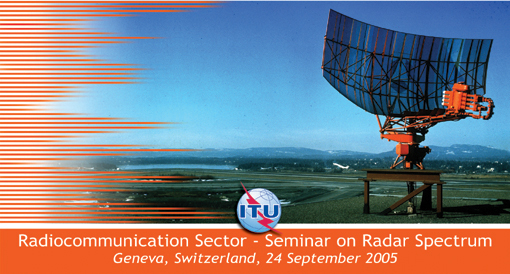Introduction
Over the past few years it has become evident that significant international regulatory attention has been focused on spectrum allocated to radiodetermination radar operations. Various ITU-R Working Parties a better understanding of how radars work, radar technological capabilities, and general radar operation both in theory and practice. There needs to be a better appreciation that radar provides a wide variety of applications for the world community from imaging and mapping to air traffic control and navigation both by air and by water as well as for weather monitoring and prediction.
Objective
The objectives of this seminar are to provide a forum to discuss, exchange views, and reflect on how radars really operate, separating what is fact and what is fiction in an effort to help the ITU better understand radar spectrum requirements, radar protection, functions, and benefits to the world. Another objective of the seminar is to provide the best information possible to national and international regulators regarding the challenges of meeting future spectrum access requirements for satisfying radar operations, address issues related to the draft work program concerning studies of the feasibility of the use of statistical and operational aspects in the protection criteria for radiodetermination radar systems, and address issues related to radar unwanted emissions.
Program outline
Radar missions, operational and spectrum requirements, architectures, and interference mitigation considerations
To understand the impact of potential interference on a specific radar application, several issues must be understood. First, the mission of the radar must be clearly defined (e.g., capture of weather related phenomena, navigation, or detection of discrete targets (e.g., boats, aircraft)). This mission requirement describes how the information gained from the radar is to be used by the operator and others who received the information. From this, the specific operational requirement as related to this mission must be determined (e.g., detection of objects of a certain size, at a maximum range, within certain time constraints, and with a specific reliability value). Alternative radar architectures or designs can be proposed to meet these mission and operational objectives. Here the hardware and software that will comprise the radar will be described. These architectures will also include specific spectrum requirements in terms of desired frequency band, number of frequencies needed, and waveform characteristics. Finally, for each of these architectural alternatives the relative impact of various types of interference (e.g., natural and man-made interference sources) on the operational performance of the radar will be described. The impact of interference sources should include details on how radar designers account for interference and its impact on the technical and operational performance requirements for each type of radar application. Emphasis should be placed on the effect of different types of interference and the impact various types of radar receiver processing techniques have in mitigating this interference in terms of these performance requirements. Each of the organizations below should follow this structure for their presentation:
- Radar mission.
- Operational requirements.
- Spectrum requirement.
- Architectures.
- Interference mitigation considerations.
This session will end with an overview by the regulatory body on radiodetermination services.ICAO/EUROCONTROL/RTCA - Aviation
IMO - Maritime Navigation
WMO/EUMETNET - Weather Radar
RCG - Modern/Advanced Radiolocation/Radar Architectures
Radar and interference
Factors to Consider for Intersystem EMC: - Interference signal structure.
- Desired signal characteristics.
- General effects to radar receiver.
- Natural noise - The impact of natural noise sources (e.g., the Sun) on the design and operation of radars.
- Man-made interference - Appropriate system (e.g., I/N) and operational (e.g., detection range) protection criteria associated with each type of radar for sharing studies in the ITU-R.
- Statistics relevant to sharing studies in the ITU-R - Variability of sharing study elements (e.g., RCS and propagation) in ITU-R analyses.
Radar Emissions
Panel Discussion
Lily Assefa and Thierry JurandSeminar Coordinators |






